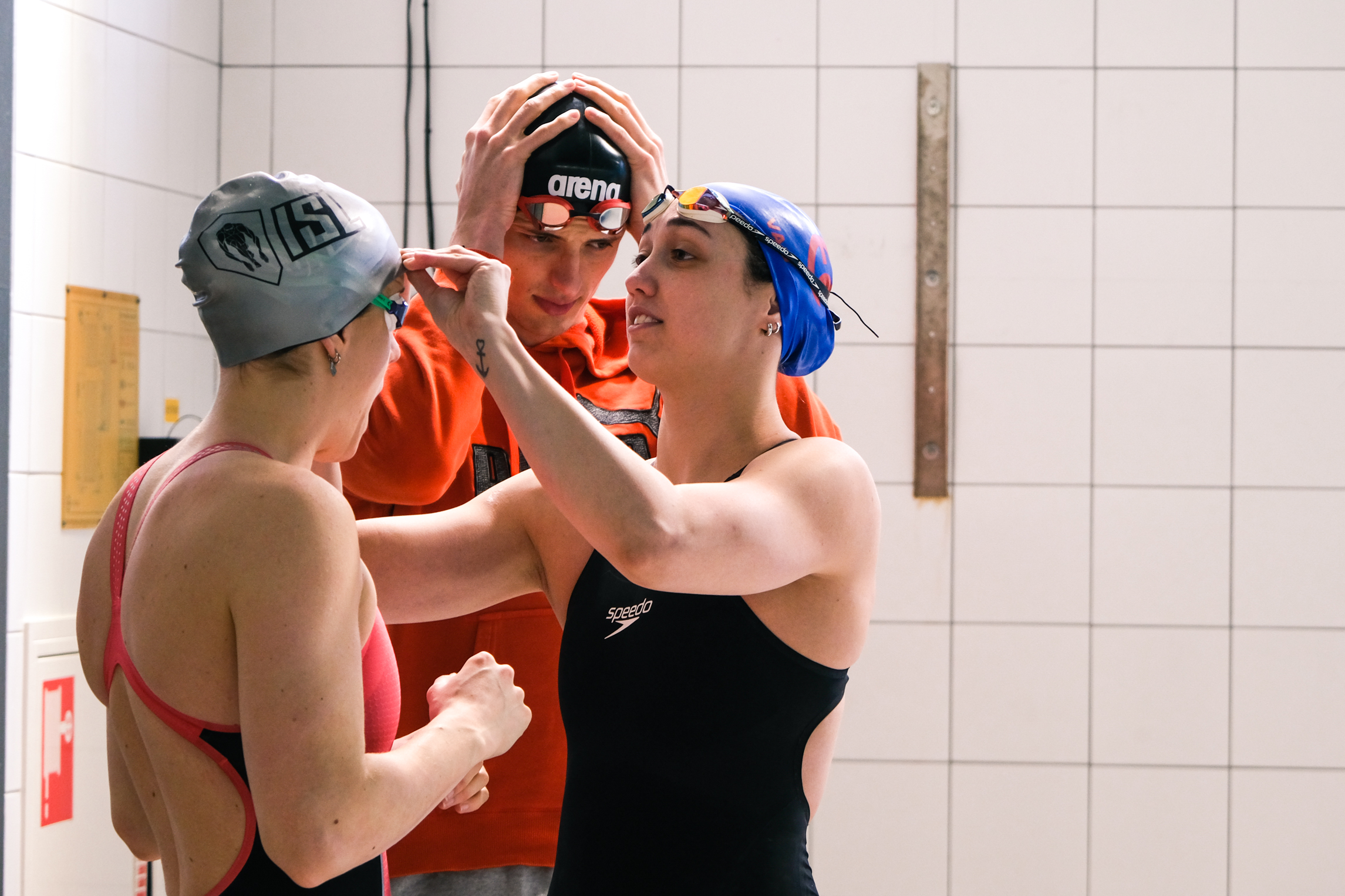When every hundredth of a second counts: cut that long hair or not?

Swimming faster with a simple adjustment. It is possible, especially if you have long hair. Alja Huibers, embedded scientist at InnoSportLab de Tongelreep (ISLT) did some research and has two tips she likes to share with you.
A small reservation though. The best thing would be to experiment my tips in the swimming pool, which is not done. My findings are basedd on scientific research by others, available literature, online videos and conversations with colleagues.
Bun high on the head
During training and competitions, I often wonder how much influence the resistance of the head has on the finishing time, especially for women. I regularly see swimmers with long beautiful hair, which disappears as a thick bun under the swimming cap. Some swimmers tie the bun high up on the head, others tie it in the neck, and still others tuck the loose hair under the bathing cap one by one. Great variation, but what is the most ideal? A lot of research has been done into the fastest swimming costume and the type of swim cap. Lycra or silicone can make a hundredths or tenths of a second difference [1, 2]. However, I have not heard much about the influence of the amount of hair under the swim cap.
So I dove into the literature. Unfortunately, no research could be found on the above conundrum: what is the most ideal thing to do with your long hair to be faster? I read about cycling, specifically the time trial. I remembered that special helmets are used, and (almost) all helmets have a 'pointy appendage' in the neck. This ensures that the airflow runs smoothly from the head to the back and thus does not get stuck in a 'vortex' in the pit of the neck [3, 4, 5].
This "vortex" has also been studied with computer simulations when swimming, related to the position of the head [6]. The position of the head during the streamline underwater certainly influences the speed and can even reduce the (passive) drag by 10 percent if you keep your head between your arms instead of lifting it slightly [6, 7]. Reading all this, I think that the position and size of the knot definitely have an effect on the drag as well.
From literature to practice...
I shared my findings with Sander Schreven, principal investigator at ISLT with over 10 years of experience in research to improve the performance of Olympic swimmers. Sander told me that in the distant past a mini study was conducted on this issue. Men who went swimming wearing both short-haired and long-haired wigs. That must have looked very comical! Apparently swimming with the wig with short hair was at least 0.10 seconds faster than with long hair.
So from the above findings, my tips would be for you, especially the swimmers with long hair:
- Position your bun at the base of your neck;
- Make sure your hair is not too long.
In extreme...
The following question comes to mind: Would there be a difference in resistance between a bun and no bun? Does the bun provide a better flow in the neck, or is a head without a bun better? Would you dare to cut your hair short for science...? 😉
Do you also have a question you can't let go of? Ask us! Who knows, maybe we have the answer or can find out for you!
- Gatta, G., Cortesi, M., & Zamparo, P. (2015). Effect of swim cap surface roughness on passive drag. The Journal of Strength & Conditioning Research, 29(11), 3253-3259.
- Marinho, D. A., Mantha, V. R., Rouboa, A. I., VilasBoas, J. P., Machado, L., Barbosa, T. M., & Silva, A. J. (2011). The effect of wearing a cap on the swimmer passive drag. In ISBS-Conference Proceedings Archive.
- Alam, F., Chowdhury, H., & Moria, H. (2019). A review on aerodynamics and hydrodynamics in sports. Energy Procedia, 160, 798-805.
- Lukes, R. A., Chin, S. B., & Haake, S. J. (2005). The understanding and development of cycling aerodynamics. Sports engineering, 8(2), 59-74.
- Sidelko, S. (2007). Benchmark of aerodynamic cycling helmets using a refined wind tunnel test protocol for helmet drag research (Doctoral dissertation, Massachusetts Institute of Technology).
- Zaidi, H., Taiar, R., Fohanno, S., & Polidori, G. (2008). Analysis of the effect of swimmer’s head position on swimming performance using computational fluid dynamics. Journal of Biomechanics, 41(6), 1350-1358
- Cortesi, M., & Gatta, G. (2015). Effect of The swimmer’s head position on passive drag. Journal of human kinetics, 49(1), 37-45.

